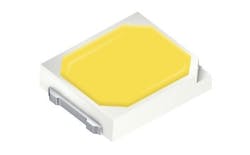ams Osram has announced a series of 2835 (2.8×3.5-mm) LEDs under the Osconiq brand including an emitter that uses quantum dot (QD) technology to more efficiently deliver excellent color rendering and warm CCTs. The new series further includes an LED with a cyan peak intended for lighting for health and wellbeing or circadian lighting applications. An 80-CRI member of the family for commercial and industrial (C&I) lighting applications completes the new series.
We have recently seen increased interest in 2835 packaged LEDs across the solid-state lighting (SSL) sector. The form factor, and more importantly the beam pattern, is a good match for the rectilinear luminaires used widely in C&I settings, including the omnipresent troffer. As mid-power LEDs have usurped the general lighting space, the 2835 components are winning a disproportionately large share of the C&I business relative to, say, LEDs with square or round light-emitting surfaces.
The 2835 opportunity has certainly caught the attention of LED manufacturers. Lumileds just announced higher-performing 2835 LEDs a few weeks ago and that was after a similar performance push in February. Osram has previously offered a 2835 LED in its Duris family of LEDs that target mainstream, specification-grade lighting products. The Osconiq family generally targets architectural, professional-grade luminaires.
The three LEDs in the Osconiq E 2835 series cover a breadth of potential deployments in the C&I and adjacent application spaces. The standard Osconiq E 2835 CRI 80 is a component that can serve in mainstream C&I applications and that would allow a luminaire manufacturer to offer a product line with luminaires varying in color quality that all use LEDs from the same family. The company said the 80-CRI component might be used in office and retail applications.
ams Osram said the 2835 QD LED offers the expected evolutionary efficacy improvements from the 3030, but largely uses the same technology platform. The company said efficacy would exceed 200 lm/W even at warm CCTs and 90 CRI. The LED will be offered over the range of 2200K to 6500K CCT.
The color quality is of course important for the intended applications, including high-end retail and hospitality, but it will also enable luminaire makers to meet the Single Lighting Regulation (SLR) policy on light source efficacy that the European Union is mandating by September 2021. The prescribed efficacy levels apply to 90-CRI LEDs and also require LEDs to offer R9 (saturated red) rendering at levels of 50 or better. The QD technology will play a big role with that new policy.
The QD performance could soon be pushed further. For now, RoHS regulations on hazardous substances limit the cadmium presence to a maximum 100 ppm (parts per million) in the phosphor formulation and thus far cadmium-free QD technology remains elusive for general illumination deployment. But ams Osram said lighting applications where the QDs are sealed and protected such as in its phosphor formulation may get exemptions from the cadmium limits by the end of this year.
The final member of the new E 2835 family is the Osconiq E 2835 Cyan, and that LED squarely targets lighting for health and wellbeing applications. The LED is not QD based. Rather, the LED appears to be based on a pair of blue pumps with the more powerful one operating in the cyan region centered at about 480 nm, while the traditional blue pump down at the 450-nm wavelength produces a relatively lesser energy peak.
We have written regularly of late about research seeking to establish the peak sensitivity wavelength of the human visual system. Last year, Circadian ZircLight said its lab identified the peak at 477 nm. More recently, BIOS and Lumileds announced an approach with a spectral power distribution (SPD) called SkyBlue with a peak at 490 nm.
Now ams Osram will have a similar tool for luminaire makers that want to offer products that can improve circadian health. The 480-nm peak would be utilized in the morning to boost alertness and ultimately to improve sleep patterns. And the cyan LED could be combined with the QD in a two-channel system that also could deliver a warm red-centric SPD later in the day and before bedtime.
LEDs Magazine chief editor MAURY WRIGHT is an electronics engineer turned technology journalist, who has focused specifically on the LED & Lighting industry for the past decade.
For up-to-the-minute LED and SSL updates, why not follow us on Twitter? You’ll find curated content and commentary, as well as information on industry events, webcasts, and surveys on our LinkedIn Company Page and our Facebook page.







